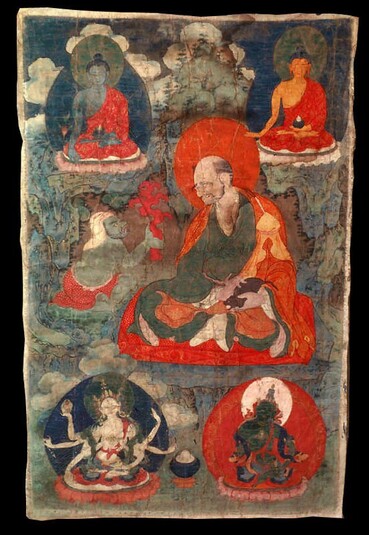
Item: Arhat/Sthavira (Buddhist Elder) - 16 Elders: Bakula
| Origin Location | Tibet |
|---|---|
| Date Range | 1700 - 1799 |
| Lineages | Buddhist |
| Material | Ground Mineral Pigment on Cotton |
| Collection | Southern Alleghenies Museum of Art |
Classification: Person
Appearance: Arhat
Gender: Male
Bakula the Elder (Sanskrit: Sthavira Bakula); one of the 16 great arhats.

Bakula appears as a wizened elder, advanced in age, typical of the group of 16 arhats. He wears loose monastic robes of various colours in the tradition of a Chinese style. On the left side he gently strokes a brown mongoose content to rest in the palm of the left hand. From his rugged mountain cave, seated on a cushion in a relaxed manner with a bright red aureole accenting the shape of the head and deep character lines of the face Bakula surveys an offering of red coral the size of a branch presented by a rough looking figure rising from a waterfall.
Spending most of his life as an ascetic Bakula only late in age embraced Dharma upon a chance meeting with the buddha Shakyamuni. Having received ordination and being renowned for his faith he quickly attained the level of an arhat. He is said to dwell on the Northern continent of Kuru where he is accompanied by a retinue of 900 fellow arhats. The special blessing which he bestows is the basic material needs and requisites for anyone seeking to follow the path of Buddha. As a symbol to convey this wish to sustain others he is shown holding a wealth bestowing mongoose.
"To the noble elder, the great Bakula of Northern Kuru, surrounded by a retinue of 900 arhats; to the feet of all those I bow." (Sakya liturgical text).
At the top left corner is the buddha of Medicine, Bhaishajayaguru, dark blue in colour, holding a healing plant in the right hand and a bowl filled with medicinal nectar in the left. To the right is a buddha performing the mudra (gesture) of fearlessness with the right hand and supporting a begging bowl with the left.
At the bottom left corner, as a special blessing emanating from the crown protuberance of the buddha, is the long-life goddess Ushnishavijaya, white in colour, with three faces and eight hands. To the right is Vajravidarana, green in colour, holding a vajra and bell; blessed with the power to remove coarse defilements.
It is rare for the individual arhats to be painted separately. The usual grouping or set of paintings would contain the buddha Shakyamuni at the forefront surrounded by the 16 arhats and accompanied by the attendant Dharmatala, the patron Hva-shang and the Four Guardians of the Directions.
Jeff Watt 7-1998
Collection of Southern Alleghenies Museum of Art
Arhat/Sthavira: Main Page & Arhat/Sthavira Appearance (Elder)
Arhat/Sthavira: Bakula Main Page
Painting Set: Arhats: Single Main Figure
Collection of Southern Alleghenies: Arhats
